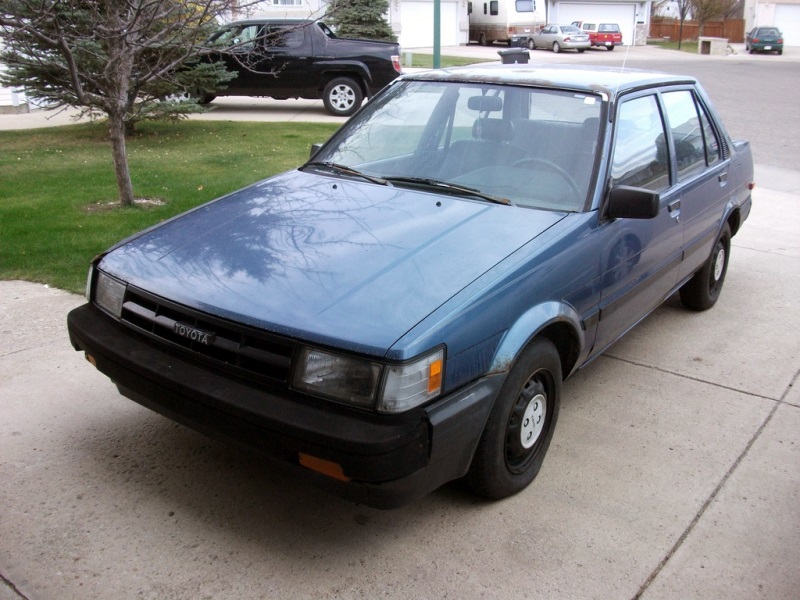
I am not a car snob—I’m really not. But even with a history of owning less-than-exciting cars like a Chrysler K-car, Ford Tempo, and a few Lada Nivas, I just couldn’t bring myself to drive this Corolla. I had hoped it would serve as my winter beater, but the sheer dullness of the overall experience was too much to bear. A car with character, even if it’s a crap car, can still be interesting. But without that spark, it becomes mundane and unappealing.
Embracing Winter Riding
Although I had managed to commute just fine by bicycle during the spring, summer, and fall months, I wasn’t too eager to face the challenges of winter riding. With temperatures occasionally dropping to -40 Fahrenheit, along with the added risk of snow and ice, I decided it was time to find a beater car to handle the winter conditions. With limited funds, frugality took precedence over curiosity or passion.

I responded to an ad for a 1987 Toyota Corolla priced at $150. It wasn’t the cool rear-wheel-drive AE86 chassis Corolla; rather, it was the more workmanlike front-wheel-drive AE82 sedan. I didn’t have much interest in the car, but I hoped I could bond with it like I did with my old Chrysler LeBaron. If not, at least it would provide reliable transportation during the winter. The car had its fair share of rust, particularly on the roof and behind the left front wheel. The exhaust had a rotted flex joint, and one of the rear quarter windows was broken. Bargaining the price down to $80, I brought it home.
Underwhelming Dullness
As I drove home, I couldn’t help but notice how incredibly dull the car felt, especially with its automatic transmission. It seemed to sap half the available engine power—a true slushbox. The car handled corners competently, but it lacked any zest or enthusiasm.

Usually, when you buy a car at scrap value, you end up with a messy vehicle filled with all sorts of odd items. My previous Scimitar came with a vintage radar detector and some horse whips, while my Lada contained cheap tools and a pair of ladies’ underwear. Sadly, the Toyota failed to deliver any interesting items; it held only an empty garbage bag, two bottles of glass cleaner, a half set of brake pads, and the factory tire wrench. The partial set of brake pads prompted me to check the front brakes, but both sides were decently worn and equally so.
Finding Hidden Potential

The glass cleaner seemed questionable for use on actual glass, and the engine was filthy. However, armed with some elbow grease and paper towels, I managed to transform the engine from an environmental disaster to a clean and presentable state. The single overhead cam 1.6L 4A-C four-cylinder engine supposedly produced 90hp, but it felt more like 70hp based on my personal observation (it actually made 74 horsepower). Despite being equipped with a carburetor and a maze of vacuum lines, the engine ran quite well.

A trip to the nearby junkyard led me to a 1986 Toyota Corolla sedan, which became my source for spare parts. It felt a bit strange pulling parts from a much nicer car than my ratty recipient at home. However, I managed to find the glass and tail light I needed in good condition, costing me a mere $30. Although I should have grabbed the exhaust flex joint, I hadn’t thought that far ahead.
Putting It All Together

I promptly installed the new-to-me parts on the Corolla. I also took the opportunity to weld in a piece of sheet metal to seal up the front fender, giving it a fresh coat of paint that surprisingly matched well with the rattle can paint from the parts store. I even put in some effort to make the peeling rims look semi-decent with a touch of leftover paint.

At this stage, the Corolla was fully functional but far from aesthetically pleasing. The exhaust still needed attention, but the cost of a proper replacement piece was higher than anticipated. I planned to take the car to a local muffler shop to have them cobble something together. However, that’s when it hit me: I didn’t like this car in any possible way. It was simply too crappy, without any redeeming character. Life is too short to drive something that doesn’t bring joy. If I was going to limp through the next few months with a beater, it should at least be something I cared about. With that realization, I sold the Corolla for a modest profit and set my sights on finding a beater car with personality.
FAQs
Q: What model of Toyota Corolla was the 1987 version?
A: The 1987 Toyota Corolla was part of the front-wheel-drive AE82 sedan lineup.
Q: Was the 1987 Corolla known for any specific issues?
A: The 1987 Corolla had issues with rust, particularly on the roof, and some problems with the exhaust system.
Q: How much horsepower did the 1987 Corolla produce?
A: The 1987 Toyota Corolla with the 1.6L 4A-C four-cylinder engine allegedly produced 90hp.
Conclusion
Although the 1987 Toyota Corolla initially seemed like a practical choice for a winter beater, it ultimately failed to captivate me. The lack of character, dull driving experience, and overall mediocrity led me to realize that life is too short to settle for a car that doesn’t bring enjoyment. I opted to sell the Corolla and find a beater car that would make the upcoming months more exciting. After all, cars should make us feel alive, not just transport us from point A to point B.